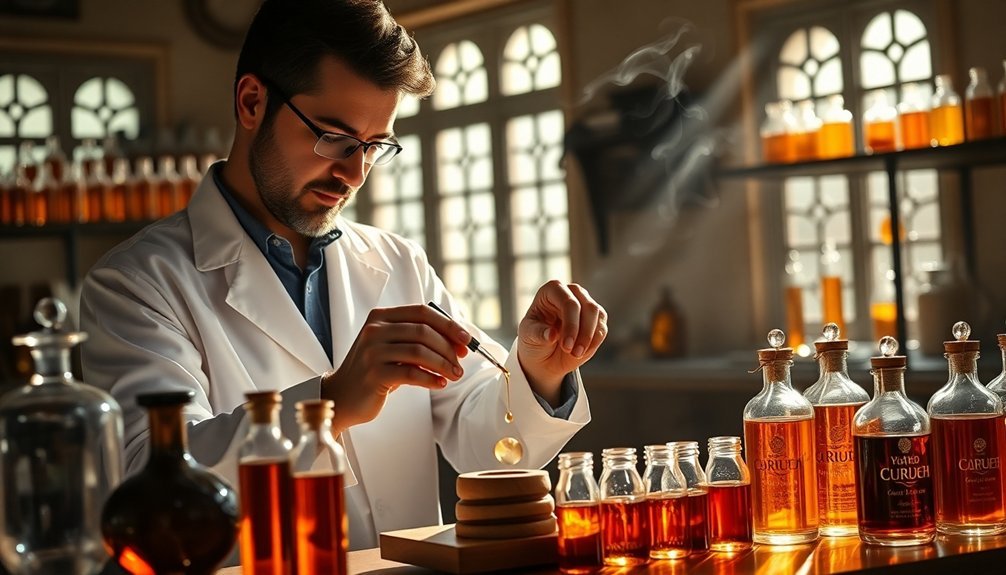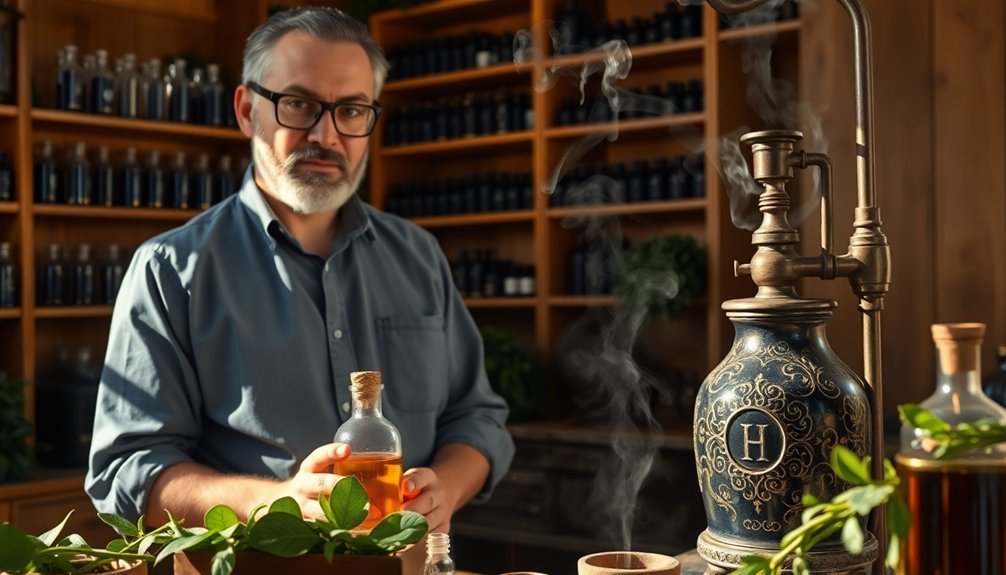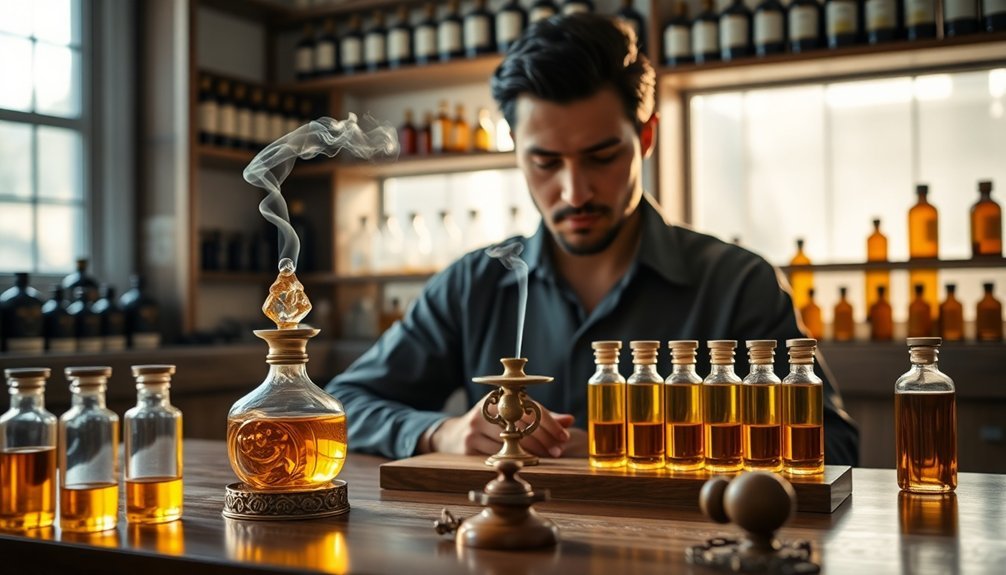Master perfumers love blending their own oud because it gives them complete creative control over this precious fragrance. You'll find they carefully select premium sources, adjust precise ratios, and patiently wait through maturation periods to craft unique signature scents. They can balance contrasting elements like dark base notes with lighter florals, creating complex aromatic profiles that evolve over time. Understanding their techniques opens up a world of artisanal perfumery possibilities.
The Ancient Art of Oud Oil Blending

While oud oil distillation dates back centuries, its complex process continues to captivate artisans and fragrance enthusiasts today.
You'll find that traditional methods involve soaking oud wood chips in water for at least ten days, which creates a distinctive fermented note. The mineral content of the water adds unique characteristics to the final product.
The process mirrors alchemy, as you can manipulate various factors to create diverse aromatic profiles. By adjusting cooking temperatures, soaking times, and aging periods, you'll discover notes ranging from lilac to chocolate to musk. Crystal glass applicators are essential during the aging process to prevent any plastic contamination from affecting the oil's purity.
A typical 70-kilo distillation yields just 20-24 grams of pure oud oil, making it precious and rare. The hydrosol byproduct holds additional value, containing suspended oud particles that contribute to the oil's complex character.
Essential Tools and Equipment for Crafting Oud
To properly blend oud, you'll need basic distillation equipment like beakers, pipettes, and dark glass bottles for storing your finished oils.
You must invest in precise measuring instruments, including a reliable scale for weighing oud chips and calibrated droppers for accurate oil measurements. A microfiber cloth is essential for keeping your workspace and delicate instruments clean while handling fragrant oils.
Your success in crafting quality oud blends depends on having the right tools, from temperature-controlled storage units to proper safety equipment like ventilation systems and protective gear.
Basic Distillation Equipment Required
Crafting oud through distillation requires four essential equipment components: a distillation vessel, a condensation system, a heating mechanism, and collection tools.
You'll need either a copper pot or stainless steel vessel with a capacity between 10-20kg for traditional distillation, or up to 350 liters for larger batches. The setup includes two glass funnels for effective material transfer and filtration.
The condensation system includes a glass condenser ball, cooling coil, and specialized separator, all insulated with 10cm polyurethane foam.
For heating, you can choose between a liquefied gas heater or electric pot, operating at temperatures up to 150°C and pressures of 2 kg/cm2.
Modern setups often use vacuum pressure to maintain temperatures below 100°C.
Finally, you'll need proper collection tools to filter and store the precious oil in a cool, dry environment.
Precise Measuring Instruments Needed
Beyond the basic distillation setup, precise measuring instruments play an essential role in creating high-quality oud.
You'll need micrometers and calipers to measure the thickness and dimensions of your wood chips precisely, ensuring ideal extraction. Digital calipers with a 9-inch throat are particularly useful for larger pieces.
To achieve consistent results, you'll want to measure your wood volumes accurately. Just as luthiers use materials like corn seed to measure bowl volumes, you can use similar techniques to measure your wood quantities.
For analyzing the final product's quality, you'll benefit from digital tools like Audacity software to examine the molecular composition and purity of your oud oil.
Precise measurements matter at every stage, from selecting and preparing the wood to monitoring the distillation process and evaluating the end product.
Selecting Premium Oud Oil Sources

When sourcing premium oud oil, the most essential factors lie in the authenticity and quality of the raw agarwood.
You'll want to focus on wild-sourced materials from regions like Vietnam, Cambodia, and Laos, where trees have naturally matured for decades. The best oils come from aged heartwood with high resin density.
Check that your supplier uses proper steam distillation methods with appropriate soaking times of 5-8 months. The distillation process shouldn't involve anaerobic fermentation, which can ruin the oil's aroma.
You'll also need to verify that only dark, resinous heartwood is used, avoiding any white wood that could dilute the fragrance.
Remember that authentic premium oud is produced in limited quantities, so be prepared to pay more for certified oils with clear provenance from reputable sources.
Mastering the Balance of Notes and Accords
When working with oud blends, you'll need to master the art of contrasting dark, rich base notes with lighter florals and citruses to create depth and intrigue.
You can achieve this balance by starting with a 3:2:1 ratio of base, middle, and top notes, then adjusting the proportions until you find your ideal composition.
The key is understanding how opposing elements like smoky leather and bright bergamot can work together while ensuring the distinctive oud character remains prominent throughout the evolution of your fragrance.
Layering Dark With Light
Although mastering the art of Oud blending requires extensive expertise, the key lies in skillfully balancing dark and light accords.
You'll need to carefully pair the intense, dark notes of Oud and styrax with lighter elements to prevent an overwhelming fragrance. Consider incorporating cashmere and velvet notes to add a soft, woody character that harmonizes with the Oud's intensity.
When you're working with stronger bases like Oud Samrat, you can reduce their concentration to minimize unwanted animalic notes.
Adding a touch of velveon musk helps clarify the blend, while black pepper introduces a spicy dimension that complements frankincense's peppery top notes.
Remember to test your blends on skin at safe dilutions to identify any imbalances and make necessary adjustments to achieve the perfect harmony.
Fine-Tuning Oud Ratios
Mastering the delicate balance of oud ratios requires a deep understanding of how different concentrations interact. You'll need to start with a higher concentration of oud and gradually adjust with complementary notes to achieve the perfect harmony.
| Base Note | Complementary Note |
|---|---|
| Assamese Oud | Rose & Saffron |
| Cambodian Oud | Sandalwood & Vanilla |
| Thai Oud | Cardamom & Jasmine |
| Bornean Oud | Cedarwood & Musk |
Begin by skin testing different dilutions to identify unwanted animalic or muddy notes. You can fine-tune your blend by adjusting oud bases – try reducing Oud samrat while introducing another oud variety. For an enhanced woody character, add small amounts of stronger notes like cedarwood or musk, but remember that precision is essential to avoid overpowering the main accord.
Harmonizing Contrasting Elements
The art of harmonizing contrasting elements in oud blends requires a deep understanding of how different notes interact across the fragrance pyramid.
You'll find that balancing contrasting accords creates dynamic, multidimensional scents that capture attention. When you pair fruity top notes with smoky oud undertones or blend floral softness with deep woody bases, you're creating sophisticated contrasts that evolve beautifully throughout the day.
- Combine sweet and sharp elements for unexpected depth
- Layer shorter-lasting scents beneath longer-lasting ones
- Use spices like cardamom and cinnamon to add warmth
- Balance floral notes with woody undertones
- Incorporate vanilla to soften intense oud characteristics
Your expertise in matching compatible fragrance families and controlling the intensity of each note will determine how well your unique blend resonates with its intended character.
Time-Tested Blending Techniques and Ratios
Successful oud blending relies on precise ratios and time-tested techniques that have evolved through generations of perfumery.
You'll want to start with your dominant note of oud and carefully build around it. When working with rose, begin with a conservative 5% ratio and adjust upward to a maximum of 25-30% for Taif rose, or 20-25% for Bulgarian varieties.
You'll notice your blend evolves as it matures, with top notes fading first while base notes deepen.
When adding complementary elements, use spices and strong ingredients like saffron sparingly. Woody notes such as cedarwood and sandalwood work well to enhance oud's natural depth, while amber and musk provide lasting power.
Remember to test your blend regularly, as the interaction between ingredients will reveal new facets of the scent over time.
The Science Behind Oud Maturation

Understanding oud maturation begins with the remarkable process that creates this precious material. When you're working with oud, you'll notice that aging transforms the oil's chemical composition through a natural process that enhances its complexity and stability.
After distillation, the oil undergoes careful blending and maturation, allowing the fragrance to develop its signature depth and character.
- The aging process helps balance volatile compounds
- Maturation refines the woody and earthy notes
- Chemical reactions during aging create new aroma molecules
- The oil becomes more stable and long-lasting
- Complex interactions between different notes create a more harmonious scent
Through this maturation period, you'll find that the oil develops a richer, more nuanced profile that's prized by master perfumers.
It's this transformation that makes aged oud so valuable in fine perfumery.
Creating Signature Oud Combinations
Building on the foundation of properly matured oud, creating signature combinations opens up a world of aromatic possibilities.
You'll discover five distinct blend categories: pure oud for traditional essence, floral fusions for softer notes, oriental spiced variations for warmth, woody-aromatic blends for earthiness, and leather-infused creations for sophistication.
When crafting your signature blend, you'll need to take into account your skin chemistry, as oud adapts uniquely to each person.
Start by exploring samples and testing different combinations over time. You can layer scents to create your distinctive fragrance, but remember to balance intensity carefully.
Whether you're seeking a daily scent or a special occasion fragrance, focus on sustainably sourced oud oils to guarantee both quality and environmental responsibility.
Quality Control and Storage Methods

To maintain the exceptional quality of your oud perfumes, proper quality control and storage methods are essential throughout the production and preservation process.
You'll need to implement stringent measures at every stage, from selecting raw materials to storing the final product. Expert teams carefully evaluate the oud's scent, moisture, and origin to guarantee it meets the highest standards.
- Store your oud perfumes in cool, dark places away from direct sunlight
- Keep bottles tightly sealed to prevent oxidation and evaporation
- Avoid bathroom storage due to humidity and temperature fluctuations
- Don't shake bottles excessively, as this can create oxidizing bubbles
- Use original packaging or opaque containers for maximum protection
Following these quality control and storage practices won't just preserve your oud – it'll guarantee you're maintaining the integrity of sustainably sourced materials while maximizing the longevity of your precious fragrances.
Frequently Asked Questions
What Psychological Effects Does Oud Have on the Wearer's Mood?
You'll experience enhanced mood through oud's calming and uplifting properties. It'll boost your confidence, evoke pleasant memories, and create feelings of tranquility. The scent can ground you during meditation or energize your spirit.
Can Allergic Reactions Occur When Wearing Oud-Based Perfumes?
Yes, you can experience allergic reactions to oud-based perfumes, including skin rashes, itching, and hives. You might also develop respiratory symptoms like sneezing and coughing, or eye irritation when wearing these fragrances.
How Does Weather and Climate Affect the Performance of Oud Perfumes?
Your oud perfume's performance varies greatly with weather: heat intensifies projection but shortens longevity, humidity helps lock in scent, and cold weather keeps fragrance closer to skin while extending its wear time.
What Makes Some Oud Perfumes Significantly More Expensive Than Others?
You'll find that oud perfumes vary in price due to the rarity of high-quality resin, complex extraction processes, aging time, luxury branding, and artisanal craftsmanship. Premium ingredients and limited availability drive costs higher.
Does the Age of the Wearer Influence How Oud Perfume Develops?
Your body chemistry and skin type influence oud's development more than age, but your natural oils can affect how the fragrance evolves. You'll notice unique scent variations regardless of how old you are.
In Summary
You'll discover that blending your own oud offers unparalleled creative freedom and satisfaction. As you master the ancient techniques, develop your nose, and experiment with different combinations, you're joining a centuries-old tradition of perfumery. Whether you're creating personal fragrances or professional formulations, your unique oud blends will tell stories that mass-produced scents simply can't match. Trust your instincts and keep refining your craft.
References
- https://irfe.com/oud-perfume/
- https://socotraoud.com/2024/01/06/how-oud-perfume-is-made/
- https://www.ensaroud.com/blog/oud-a-detailed-guide/
- https://www.crescentoud.com/the-role-and-usage-techniques-of-agarwood-oil-in-perfume-blending/
- https://www.azizun.com/oud-blog/captivating-world-oud-perfume
- https://www.ensaroud.com/blog/how-to-apply-oud/
- http://mit.edu/~ecprice/Public/freq/googlelist.counts
- https://takeonethingoff.com/blog/2021/11/12/foundational-essential-oils-part-2-oud/
- https://www.theperfumist.com/blogs/news/how-to-apply-oud-oil
- https://www.youtube.com/watch?v=x6Og_3CASMI





Leave a Reply